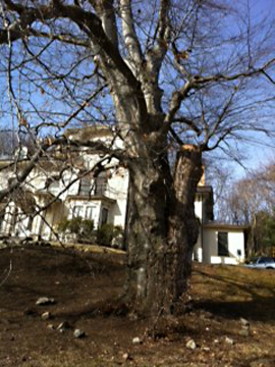 |
Winslow Homer’s 1866 painting, "Croquet on the Lawn," currently in Chicago Museum of Fine Arts, shows two beech trees in front of his family house in Belmont, Massachusetts.
As long as anyone can remember, there have been two beautiful, huge Copper Beech trees on the lawn of the famous Homer House, which is now the Women’s Club in Belmont. They were both growing there in 1866 in Winslow Homer’s series of croquet paintings.
But, now there is just one. People paying this year’s 2012 taxes at Town Hall across the street, were shocked to see that venerable landmark being taken down. Huge limbs were loaded into a Tree Services truck by a special crane much taller than the tree or the house.
A stump, 7 feet in diameter (21 feet in circumference) is all that remains of one of the beloved trees and, surprisingly, there is no rot in the 150-year-old base. The other beech had one decayed trunk pruned away.
Unfortunately, trees do not live forever. Eventually they develop cracks and rot and become hollow. The growth of a particular mushroom fungus, growing at the base of both trees, was a sign of trouble brewing inside.
Some History About Belmont’s Ancient Beech Trees
A story told is that there used to be a little man who came around each year with European Beech seedlings in his wagon. He made grafted Copper Beeches, and also seedlings of the purple European Beech. The Victorians loved them, and so they grow all over town. Fortunately, Belmont still has several ancient beeches remaining, just not as famous at Homer’s croquet on the lawn paintings.
The yellowwood trees behind the Women’s Club are first generation seedlings of a National Champion Tree actually planted by Winslow Homer, himself, just across the street. It was the largest Champion Yellowwood in the whole United States in the 1990’s, but unfortunately it had to be removed a few years ago. It was all hollow rotten inside.
 |
Care of Old Beeches
The most important thing for preservation of all old trees is that they do not become "hazards", a technical term which means that a large limb could fall. And at any time, it’s especially important where there are lots of cars and people walking, particularly in a widely used public place. Last year, in Belmont, there was a very tragic death of a child from a fallen tree limb in a private yard.
A long time resident, after watching her beloved beech tree being taken down, angrily called me and said, "Why are they taking down this precious tree, and who decided to ruin this loveliest front yard in town?" And added, "Why weren’t we warned?" Most people don’t understand the very complex safety evaluation of trees, especially old ones.
The Women’s Club has been working hard to preserve these trees, as long as anyone can remember. In 1995, the trees had a special pruning and other work done on them. The Curator of the Plant Collection at the Mount Auburn Cemetery gave this advice.
First mulch a big area under the trees, because beeches’ survival requires a very complex set of underground organisms. Also, don’t ever grow grass under them, and never, never use herbicides on the adjacent lawn. Additionally, avoid fertilizer on really ancient trees or use it very sparingly, several years apart.
The Women’s Club, in about 2010, joined with the Belmont Land Trust to preserve the historic open space and landscaping around the Homer House. There were many sessions about the beech trees and also the historic yellowwood trees behind the house. Some experts were consulted, including Certified Arborists and the Mount Auburn Cemetery.
But grass was allowed to grow under the trees. Winter moths attacked it. There was no mulch protecting the whole root run. The tree was declining. It may have been fertilized.
Sadly, a dangerous, hazardous crack was noticed. Although we all love and cherish old trees, there comes a time when people’s safety must come before their love for a memorable town landmark.
Credit: www.mothersgarden.net




























